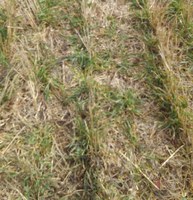NDSU Extension Offers Rye Management Advice
(Click the image below to view a high-resolution image that can be downloaded)
With the late spring and relatively good price for rye seed, growers that planted rye last fall as a cover crop are now considering taking it to harvest and selling it for seed, says Joel Ransom, North Dakota State University Extension cereal crop agronomist.
“Rye has relatively good yield potential in North Dakota, where the average yield was about 60 bushels per acre in variety trials conducted across the state,” Ransom adds. “If water during the season is not to be limiting, one might expect yields of 70 bushels per acre or more with our current varieties.”
With the recent warmer weather, rye is now coming out of dormancy and winter survival of the crop can be assessed.
According to Ransom, the optimum plant population for winter rye is 21 to 23 plants per square foot.
Stands as low as 10 to 12 plants per square foot should yield well and should be retained as long as there are no large areas of the field or frequent large gaps where there are little or no plants, as controlling weeds in these areas will be problematic.
“Rye requires less nitrogen than spring wheat,” says David Franzen, NDSU Extension soil fertility specialist. “For a 60 bushels per acre crop, 100 pounds of nitrogen minus soil test nitrogen and any previous crop credit should be adequate.”
Since commonly grown rye varieties are tall and tend to lodge and there is no premium or discount for protein when grown for seed, growers should not over fertilize their crop. Applying nitrogen in the spring should occur as soon as it is practical to get into the field and for maximum effect on yield, and before the 5 to 6 leaf stage, if possible.
If urea is used, consider applying with a urease inhibitor, unless it is likely to rain in the next few days.
The risk for foliar diseases likely is low in rye, according to Andrew Friskop, NDSU Extension plant pathologist.
Leaf rust can be observed on rye but the pathogen doesn’t overwinter in North Dakota and the spores are usually blown up from the south, so if it develops, it will likely be late in the season.
If rye was planted on non-rye ground, your risk from fungal leaf spots also will be low. Therefore, a fungicide targeting foliar diseases likely is not needed.
Rye may benefit from a foliar fungicide application at flowering to help manage Fusarium head blight (FHB) and protect yield, especially in a season that is conducive to the development of this disease. However, winter rye often will mature early enough that it will miss the window of high FHB risk. It is also considered more tolerant to FHB than wheat and barley.
Not all fungicides labeled for use in wheat are labeled for rye. Proline and Caramba are recommended options for FHB control. Both are quite expensive for a rye crop, so make a decision using multiple factors (ie: scab risk, yield potential, end-use, etc).
The timing of a fungicide often is the most difficult part in the application process. With rye’s long window of flowering, it can be difficult to assess the best time. As a guideline, the more yellow anthers (early-anthesis to late anthesis) on the main stems the better.
“Also, I would rather apply a fungicide too late rather than too early”, says Friskop.
Having a good handle on how to market the crop may be important. The current attractive price may not remain if supply exceeds the demand later this summer.
NDSU Agriculture Communication - April 30, 2019
| Source: | Joel Ransom, 701-231-7405, joel.ransom@ndsu.edu |
|---|---|
| Source: | David Franzen, 701-799-2565, david.franzen@ndsu.edu |
| Source: | Andrew Friskop, 701-231-7627, andrew.j.friskop@ndsu.edu |
| Editor: | Kelli Anderson, 701-231-6136, kelli.c.anderson@ndsu.edu |


